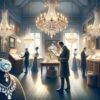Preserving the Past: The Artistry Behind Victorian-Style Diamond Earrings
The Victorian era, spanning from 1837 to 1901, is renowned for its opulent fashion, extravagant lifestyles, and exquisite jewelry. One of the most enduring and captivating facets of Victorian jewelry is the artistry behind diamond earrings of that era. These pieces not only epitomize the grandeur of the Victorian period but also showcase the unparalleled craftsmanship that continues to captivate jewelry enthusiasts today. In this article, we delve deeper into the world of Victorian-style diamond earrings, exploring their historical context, the materials and gemstones used, the intricate techniques and artistry involved in their creation, and the significance of collecting and preserving these timeless treasures.

Historical Context of Victorian Jewelry
The Victorian era, named after Queen Victoria of England, was a time of profound cultural and social change. It can be divided into several distinct periods, each influencing jewelry styles differently. Early Victorian jewelry, also known as the Romantic period, was marked by romantic and sentimental motifs. Lockets containing strands of hair from loved ones, as well as symbolic designs such as hearts and flowers, reflected the deep emotions of the time. The mid-Victorian era, on the other hand, embraced the mournful elegance of mourning jewelry. Jet, onyx, and black enamel were frequently used to create somber yet captivating pieces adorned with intricate patterns and symbolism.
In the late Victorian period, known as the Aesthetic period, jewelry design experienced a revival of historical elements. This era was characterized by a fascination with the past, with jewelry featuring motifs inspired by ancient cultures, such as Egyptian, Etruscan, and Renaissance designs. The artistry of Victorian jewelry transcended mere adornment; it became a means of expressing emotions, status, and cultural appreciation.
Popular Materials and Design Elements
Victorian jewelry was known for its use of a wide range of materials. Yellow and rose gold were highly favored, and they provided a warm backdrop for the jewelry’s intricate designs. Silver and platinum were also used, but less frequently, often reserved for more delicate pieces. Gemstones and pearls were carefully selected to complement the designs. Sapphires, emeralds, and rubies, along with diamonds, were popular choices. Pearls, symbolizing purity and innocence, were particularly cherished and adorned both necklaces and earrings.
Perhaps the most iconic design element of Victorian jewelry is its use of symbolism. Jewelry was not just an accessory but also a means of conveying sentiments and messages. Motifs such as hearts, anchors, snakes, and ivy leaves symbolized love, hope, eternity, and fidelity, respectively. The use of symbolism added depth and meaning to the pieces, making them cherished heirlooms.
Intricate filigree work, a technique of weaving thin threads of metal to create lacy patterns, was a hallmark of Victorian jewelry. This delicate craftsmanship added a sense of lightness and elegance to even the most substantial pieces. Enameling, another technique employed, allowed for the addition of vibrant colors to the jewelry, enhancing their visual appeal. Hand-painted details showcased the skill of the artisans, with miniature portraits and intricate designs adorning lockets and brooches.
Victorian-Style Diamond Earrings
Victorian-style diamond earrings are a testament to the era’s attention to detail and aesthetic sensibility. These earrings typically feature old mine-cut or rose-cut diamonds, which were popular during the period. These cuts, with their fewer facets and unique sparkle, provide a distinct vintage charm. The settings were frequently ornate, with delicate filigree work and enamel accents. These earrings radiated an aura of sophistication and femininity, making them highly sought after then and now.
Materials and Gemstones
Victorian-style diamond earrings are a captivating blend of exquisite diamonds and other precious gemstones. Diamonds, often the centerpiece of these earrings, held a significant symbolic meaning in Victorian society. They represented purity, eternity, and enduring love, making them the perfect choice for sentimental and romantic jewelry pieces.
During the late Victorian era, the fascination with diamonds grew exponentially with the discovery of diamond mines in South Africa. This newfound source of diamonds led to increased availability, making diamonds more accessible to a wider range of consumers. As a result, Victorian-style diamond earrings became increasingly popular and adorned by women of various social classes.
In addition to diamonds, these earrings frequently incorporated a symphony of other gemstones. Pearls, often associated with purity and innocence, were a favorite among Victorians and featured prominently in many designs. Their lustrous sheen complemented the sparkle of diamonds beautifully. Sapphires, with their rich blue hues, were also prized for their elegance and were often used as accents in Victorian earrings.
Emeralds, with their lush green color, added a touch of luxury and vibrancy to some pieces. These gemstones were chosen not only for their aesthetic appeal but also for the meaning they conveyed. Each gemstone carried its own symbolism, and the careful selection and arrangement of these stones added depth and personal significance to Victorian-style diamond earrings.
Seed pearls, in particular, played a unique role in Victorian jewelry. These tiny, delicate pearls were often used to create intricate patterns and add texture to the designs. Seed pearls were appreciated for their ethereal beauty, and their use in earrings and other jewelry items gave these pieces a distinctive and intricate charm.
Techniques and Artistry
Victorian-style diamond earrings stand as masterpieces of craftsmanship and artistry, reflecting the dedication and skill of the artisans who created them. These earrings boast a combination of techniques that were refined over generations:
- Filigree Work: Filigree, characterized by weaving thin threads of metal to create lacy and intricate patterns, was a hallmark technique of Victorian jewelry. In earrings, filigree work was used to form delicate frameworks that held gemstones and diamonds in place. The intricate designs in filigree added a sense of lightness and airiness to these pieces, making them both visually captivating and comfortable to wear.
- Enameling: Enameling was another technique employed in Victorian-style diamond earrings. Artisans used enamel to add vibrant colors to the jewelry. This technique allowed for the creation of intricate patterns and designs that enhanced the overall visual appeal of the earrings. Enameling often provided a striking contrast to the sparkle of diamonds, making these pieces even more captivating.
- Hand-Painted Details: Some Victorian earrings featured hand-painted details, showcasing the incredible skill of the artisans. These details could include miniature portraits, floral motifs, or intricate scenes. Such intricate hand-painted elements added a personalized touch to the jewelry, making each piece unique and significant to its wearer.
The meticulous combination of these techniques, along with the keen attention to detail, transformed Victorian-style diamond earrings into more than just adornments. They were, and continue to be, wearable works of art that tell stories of love, sentimentality, and the artistic values of the Victorian era.
Collecting and Preserving Victorian-Style Diamond Earrings
For collectors and enthusiasts, the journey of acquiring and preserving Victorian-style diamond earrings is a captivating one. Ensuring the authenticity and value of these pieces is paramount. Here are some key considerations:
- Authentication: Genuine Victorian jewelry may bear hallmarks or maker’s marks, but these can be faint, obscured by wear, or even absent due to repairs over the years. Working with reputable dealers and experts is crucial to verify the authenticity of a piece.
- Documentation: If available, historical documentation or provenance can provide valuable insights into the history and authenticity of Victorian-style diamond earrings. Records of previous owners and any accompanying certificates can be valuable additions to your collection.
- Condition: Assessing the condition of the earrings is essential. Vintage pieces may show signs of wear, but significant damage or extensive repairs can affect their value. Carefully inspect settings, gemstones, and any enameling or hand-painted details.
- Proper Care: Once acquired, taking proper care of Victorian-style diamond earrings is essential to preserve their beauty and value. Clean them gently and store them in a suitable jewelry box or pouch to prevent scratches and damage. Avoid exposing them to harsh chemicals or extreme temperatures.
- Appraisals: Periodic appraisals by qualified professionals can help determine the current value of your Victorian-style earrings. This is especially important for insurance purposes and for keeping track of their worth over time.
Victorian-style diamond earrings are not just accessories; they are pieces of history and art. They reflect the cultural nuances and artistic trends of a bygone era, while their enduring appeal continues to inspire contemporary jewelry designers. Owning and appreciating these exquisite earrings is not only a celebration of the past but also a testament to the enduring allure of Victorian craftsmanship in the world of fine jewelry. In preserving these treasures, we not only honor the past but also ensure that their timeless beauty continues to shine in the present and future.


